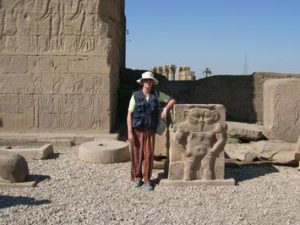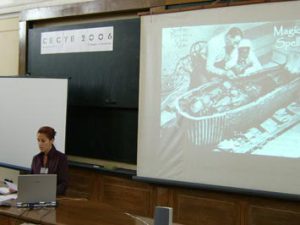 Egyptology researcher Paula Veiga, author of Health and Medicine in Ancient Egypt: Magic and Science is fascinated by the ancient Egyptians’ concepts of health and medical practice. We caught up with her to chat about religion, medicine and magic, and what lessons health professionals can learn from studying the ancient world.
Egyptology researcher Paula Veiga, author of Health and Medicine in Ancient Egypt: Magic and Science is fascinated by the ancient Egyptians’ concepts of health and medical practice. We caught up with her to chat about religion, medicine and magic, and what lessons health professionals can learn from studying the ancient world.
HK: Your background is in tourism – how did you go from tourism to religion, infectious diseases, medicine and magic in Egypt?
PV: I have been attracted to ancient history since I was a child, and I collected all those National Geographic editions on ancient civilisations – my favourite being Egypt. When I finished high school, Hotel Management was a new course, and it was very attractive because it included history, travelling and speaking foreign languages (I was already fluent in English and French, and a conversational user of Spanish). So I studied for two degrees: Hotel Management and Tourism Information, and worked in these areas from 1989 until 2003. During my life I have had some serious health issues, and that helped me learn much about medicine. I left my last job in 2003 and started to study Pre-Classical History and Cultures. I came across what Egyptians had on medicine, I learned about the medical Papyri, and decided to focus my research on that. As magic, religion and medicine are lines in the same thread in ancient Egyptian beliefs, I have dedicated myself to them.
HK: When most people think of magic, they think of Harry Potter, or magic spells and witches.
PV: Magic in ancient Egypt was also about figurines, spells and potions. But the essential ingredient was the word. Words considered magical were very powerful and they were part of medicinal prescriptions. If we look at some Middle Eastern, African, Afro-Caribbeean and South American societies today, they still use ‘enchanted’ words to go along with ‘healing’ practices.
HK: How are magic and religion related?
PV: In ancient Egypt these two concepts were together in all rituals. The myths, the gods and the practices belonging to ancient Egyptian beliefs were transported to the words used in magic. The dead were divinised from some point in Egyptian history, and all acts in their daily lives were influenced by magic and religious issues. They had personal altars at home (most of rural Egypt has not changed in this regard) and they regarded some gods as crucial to some phases in life such as pregnancy, childbirth and travelling.
 HK: Your book Oncology and Infectious Diseases in ancient Egypt is based on your study of the Ebers Papyrus. Can you tell us a bit about the study and how difficult a subject it was to research?
HK: Your book Oncology and Infectious Diseases in ancient Egypt is based on your study of the Ebers Papyrus. Can you tell us a bit about the study and how difficult a subject it was to research?
PV: The book collects data from material that show the presence of a tumour, and some interpretations of those by professionals, as well as data from the 21 paragraphs of the Ebers Papyrus concerning what are thought to have been oncological concerns. After the research – and new data appears every day – we must say that those 21 paragraphs may not have been all about tumours. They (ancient Egyptians) used similar terms for cysts, benign masses (tumours that are not fatal), varicose veins and other conditions. I presented on this at the Bolzano Mummy Congress in March.
The subject is difficult to research as there are not many traces of tumours in a mummified or skeletised body – the majority of data is shown in the bones, and also because not many examples have been found yet from ancient Egypt to allow us to have rock-solid conclusions.
HK: Your other book is Health and Medicine in Ancient Egypt: Magic and Science – are there any lessons the modern world can take from life in ancient Egypt when it comes to health and medicine?
PV: I believe there are. Our society is turning to eco-solutions in food and health like organic food and crops with no pesticides, organic cosmetics and household cleaning items, natural remedies (phytotherapy, Bach florals, traditional Chinese medicines, homeopathy) – even the mainstream brands are adopting a more ‘natural’ approach. Still much is to be found from ancient Egyptians as there a number of plants and other ingredients still unidentified in medical papyri.
The research for cures and the ingredients in medicines are of special appeal if you study ancient civilisations, as you discover that they used the active substances of plants, minerals and animals to treat pathologies and prevent diseases. How they knew that is a mystery, as they had incipient scientific tools and methods.
HK: You’re also deciphering hieroglyphs on an ancient coffin in a Portuguese museum. Sounds fascinating.
PV: I am going to start that soon – I have been learning more about hieroglyphic writing. It is a team project in Porto that includes two Egyptian mummies, one with a sarcophagus. I presented the preliminary results of the study of the male mummy in Manchester and Cairo back in 2008.
HK: And you still have time for a PhD…
PV: I am still writing the proposal – I’m giving mummies a rest and embarking on religion and magic again. Still, it is connected to medicine as it is about medicinal plants, some of them associated with some gods of ancient Egypt.
HK: What aspect of your work do you enjoy most?
PV: Finding out associations, trying to think like an ancient Egyptian and, of course, the most rewarding part is going to Egypt and discovering that most of the beliefs are still embedded in people’s daily lives.
HK: You must get asked a lot of interesting questions at dinner parties.
PV: The best ones are asked by children. Adults ask many stupid questions because people in general tend to speak before they think. Children have a special logic – one that’s much more reasonable – and they pick up details that adults miss.
The last one I had was from the 10-year-old daughter of a good friend of mine. She was very worried about me being around dead people. She did not understand how I got information from mummies. I had to explain how the body is in a state of conservation, the ethics (that was her real concern), and the instruments and techniques we use. I still had to send her mother some pictures for her to see what a mummy looks like. Children are the future generation and they need to learn and understand.
HK: What’s next for Paula Veiga?
PV: Next is the PhD. In between, I’m starting to pay more attention to friends who are working in excavation sites in Egypt so that I can participate in one to get some experience. I am also an amateur photographer and I would really like to collaborate with an excavation team. I will also continue to participate in international meetings and to present my research. I have another projects but they are sitting tight for the moment – I have to concentrate on the PhD.
